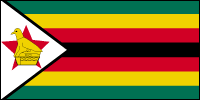| Country (long form) |
Republic of Zimbabwe |
| Capital |
Harare |
| Total Area |
150,803.78 sq mi
390,580.00 sq km
(slightly larger than Montana) |
| Population |
11,365,366 (July 2001 est.)
note: estimates for this country explicitly take into account the effects of excess mortality due to AIDS; this can result in lower life expectancy, higher infant mortality and death rates, lower population and growth rates, and changes in the distribution of population by age and sex than would otherwise be expected |
| Estimated Population in 2050 |
9,276,696 |
| Languages |
English (official), Shona, Sindebele (the language of the Ndebele, sometimes called Ndebele), numerous but minor tribal dialects |
| Literacy |
85.0% total, 90.0% male, 80% female (1995 est.) |
| Religions |
syncretic (part Christian, part indigenous beliefs) 50%, Christian 25%, indigenous beliefs 24%, Muslim and other 1% |
| Life Expectancy |
38.51 male, 35.7 female (2001 est.) |
| Government Type |
parliamentary democracy |
| Currency |
1 Zimbabwean dollar (Z$) = 100 cents |
| GDP (per capita) |
$2,500 (2000 est.) |
| Industry |
mining (coal, gold, copper, nickel, tin, clay, numerous metallic and nonmetallic ores), steel, wood products, cement, chemicals, fertilizer, clothing and footwear, foodstuffs, beverages |
| Agriculture |
corn, cotton, tobacco, wheat, coffee, sugarcane, peanuts; cattle, sheep, goats, pigs |
| Arable Land |
7% |
| Natural Resources |
coal, chromium ore, asbestos, gold, nickel, copper, iron ore, vanadium, lithium, tin, platinum group metals |
|


|